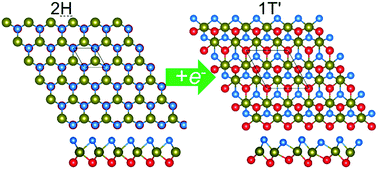2H → 1T′ phase transformation in Janus monolayer MoSSe and MoSTe: an efficient hole injection contact for 2H-MoS2†
Abstract
Two-dimensional (2D) transition metal dichalcogenides (TMDs) have attracted much scientific attention for applications in nanoelectronic and optoelectronic devices. The physical and chemical properties of 2D TMDs depend on their phase structures. In this study, electron doping-induced 2H → 1T′ structural transformation of MoS2, Janus MoSSe and MoSTe monolayers was studied by using density functional theory. Phonon dispersion calculation showed that both 2H- and 1T′-MoSX (X–S, Se and Te) monolayers were dynamically stable. Janus monolayer 2H-MoSX exhibited band gap of 1.0–1.68 eV, whereas Janus monolayer 1T′-MoSX was found to be a semiconductor with narrow band gap of 0.13–0.26 eV. The critical values of electron concentration to trigger 2H → 1T′ structural phase transformation decreased as X atom changed from S to Te in MoSX (X–S, Se and Te) monolayer. The in-plane stiffness decreased with increasing electron concentration for 2H-phase, whereas that of the 1T′-phase changed slightly with electron concentration; thus, electron doping destabilized the crystal structure of 2H-phase. The 1T′-phase could provide an efficient hole injection contact to 2H-MoS2 for use in nano-electronic devices.



 Please wait while we load your content...
Please wait while we load your content...